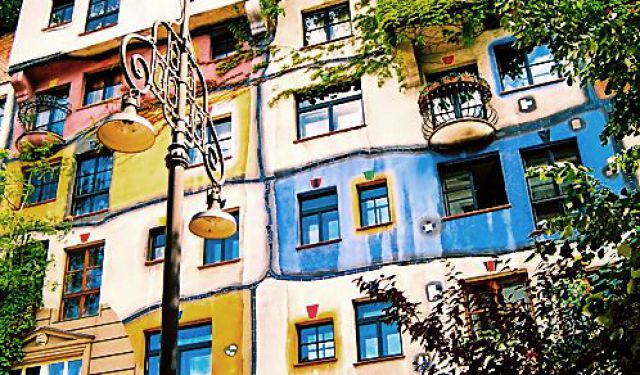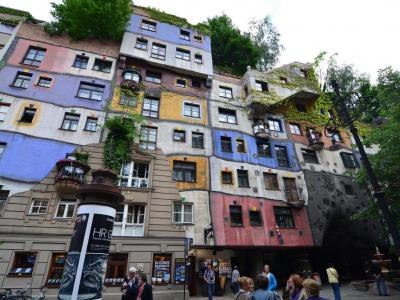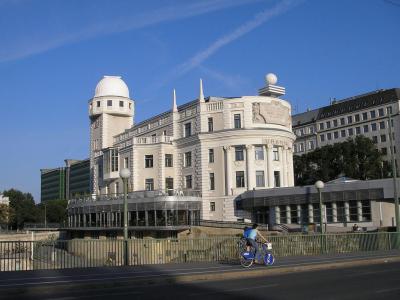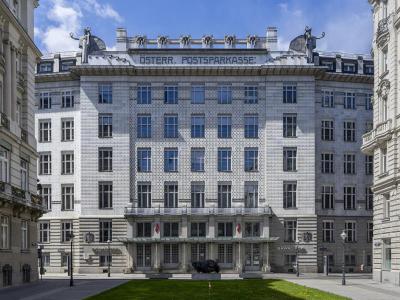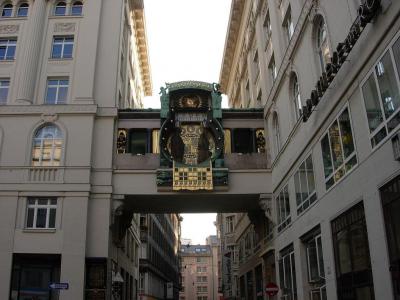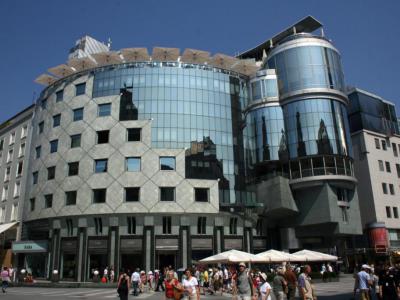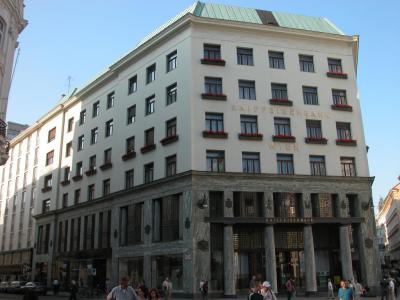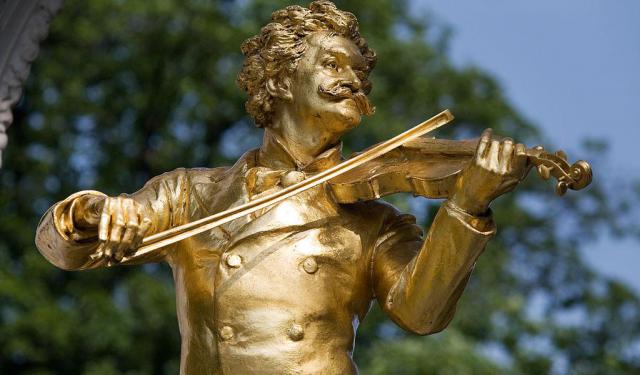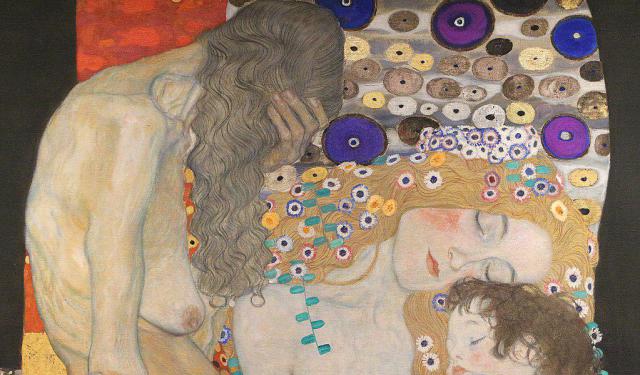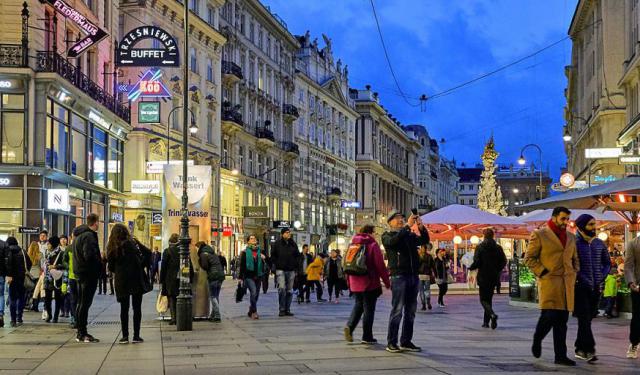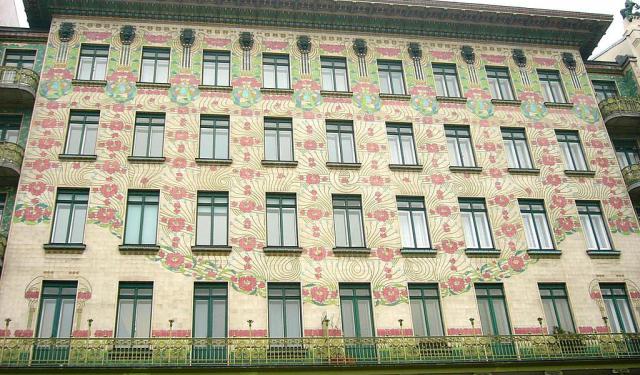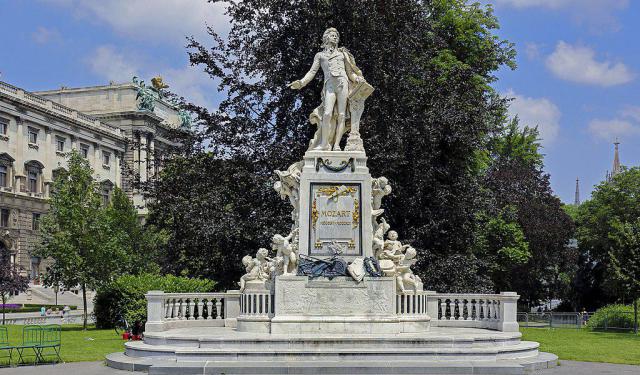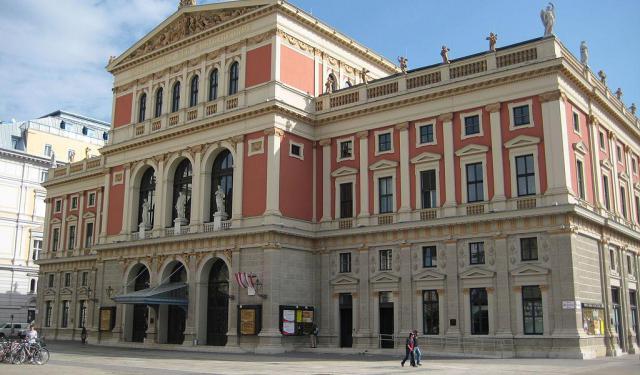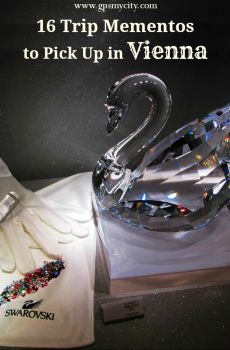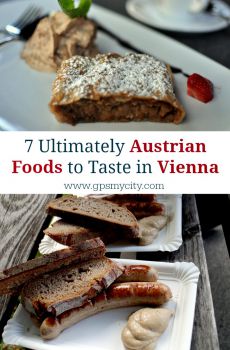Audio Guide: Vienna's Art Nouveau Architecture Tour I (Self Guided), Vienna
Vienna’s flirtation with Art Nouveau-known locally as Jugendstil-unfolded in the late 19th, early 20th centuries. The so-called Vienna Secession movement, which emerged in 1897, was led by a group of rebellious artists and architects like Otto Wagner, Gustav Klimt, and Koloman Moser, who turned their backs on historicism in favor of bold, modern aesthetics. As the new language for buildings, interiors, and urban objects, they introduced сlean lines, flowing ornament, and a touch of nature’s whimsy.
As a result, today, Vienna is practically winking at you from every street corner with its Art Nouveau charm. Among its most colorful examples are the Hundertwasser House and Art House Vienna, both designed by Friedensreich Hundertwasser. Though built in the 1980s, these psychedelic playgrounds with their wild forms, curved floors, rooftop greenery, and not a straight line in sight, embody the movement’s organic spirit. The nearby Art House Vienna museum lets you peek inside Hundertwasser’s visionary work and environmental ideals.
If you're feeling cerebral, head over to the Urania Observatory, where art meets astronomy in a building designed by Max Fabiani in 1910. Originally conceived as a beacon of knowledge by the Danube Canal, it now hosts a cinema, observatory, and lectures-plus a fair amount of Art Nouveau flair tucked among the neoclassical bones.
And if clean lines and metal rivets make your heart flutter, don’t miss Otto Wagner’s Postal Savings Bank. Completed in 1906, its use of aluminum, glass, and unapologetic functionality was truly revolutionary-basically the Apple Store of its time, minus the Genius Bar...
In contrast, Loos House, designed by Adolf Loos in 1910, shocked Viennese society with its austere, ornament-free façade. Though opposed to Art Nouveau decoration, Loos (ever the contrarian) contributed to the era’s architectural dialogue and helped pave the way for modernism with a design so minimalist, it still looks avant-garde.
Fast forward to 1987 and say hello to Haas House, Hans Hollein’s postmodern mirror-glass wink to St. Stephen’s Cathedral. It’s as if Art Nouveau popped on a new outfit and joined the '80s...
Another delightful landmark is the deliciously eccentric Anchor Clock, designed by Franz von Matsch in 1914, which features famous historical figures parading across the dial every day at noon-a charming reminder of Art Nouveau’s decorative playfulness. Who said time can’t be theatrical?
Beyond these icons, stroll Vienna’s Naschmarkt or Linke Wienzeile and you’ll find yourself inside a living museum of curves, color, and cultural sass. Art Nouveau may have started as a rebellion, but in Vienna, it aged into an architectural love affair that still turns heads.
As a result, today, Vienna is practically winking at you from every street corner with its Art Nouveau charm. Among its most colorful examples are the Hundertwasser House and Art House Vienna, both designed by Friedensreich Hundertwasser. Though built in the 1980s, these psychedelic playgrounds with their wild forms, curved floors, rooftop greenery, and not a straight line in sight, embody the movement’s organic spirit. The nearby Art House Vienna museum lets you peek inside Hundertwasser’s visionary work and environmental ideals.
If you're feeling cerebral, head over to the Urania Observatory, where art meets astronomy in a building designed by Max Fabiani in 1910. Originally conceived as a beacon of knowledge by the Danube Canal, it now hosts a cinema, observatory, and lectures-plus a fair amount of Art Nouveau flair tucked among the neoclassical bones.
And if clean lines and metal rivets make your heart flutter, don’t miss Otto Wagner’s Postal Savings Bank. Completed in 1906, its use of aluminum, glass, and unapologetic functionality was truly revolutionary-basically the Apple Store of its time, minus the Genius Bar...
In contrast, Loos House, designed by Adolf Loos in 1910, shocked Viennese society with its austere, ornament-free façade. Though opposed to Art Nouveau decoration, Loos (ever the contrarian) contributed to the era’s architectural dialogue and helped pave the way for modernism with a design so minimalist, it still looks avant-garde.
Fast forward to 1987 and say hello to Haas House, Hans Hollein’s postmodern mirror-glass wink to St. Stephen’s Cathedral. It’s as if Art Nouveau popped on a new outfit and joined the '80s...
Another delightful landmark is the deliciously eccentric Anchor Clock, designed by Franz von Matsch in 1914, which features famous historical figures parading across the dial every day at noon-a charming reminder of Art Nouveau’s decorative playfulness. Who said time can’t be theatrical?
Beyond these icons, stroll Vienna’s Naschmarkt or Linke Wienzeile and you’ll find yourself inside a living museum of curves, color, and cultural sass. Art Nouveau may have started as a rebellion, but in Vienna, it aged into an architectural love affair that still turns heads.
How it works: Download the app "GPSmyCity: Walks in 1K+ Cities" from Apple App Store or Google Play Store to your mobile phone or tablet. The app turns your mobile device into a personal tour guide and its built-in GPS navigation functions guide you from one tour stop to next. The app works offline, so no data plan is needed when traveling abroad.
Vienna's Art Nouveau Architecture Tour I Map
Guide Name: Vienna's Art Nouveau Architecture Tour I
Guide Location: Austria » Vienna (See other walking tours in Vienna)
Guide Type: Self-guided Walking Tour (Sightseeing)
# of Attractions: 7
Tour Duration: 2 Hour(s)
Travel Distance: 3.4 Km or 2.1 Miles
Author: leticia
Sight(s) Featured in This Guide:
Guide Location: Austria » Vienna (See other walking tours in Vienna)
Guide Type: Self-guided Walking Tour (Sightseeing)
# of Attractions: 7
Tour Duration: 2 Hour(s)
Travel Distance: 3.4 Km or 2.1 Miles
Author: leticia
Sight(s) Featured in This Guide:
- Hundertwasser House
- KunstHaus (Art House Vienna) / Museum Hundertwasser
- Urania Observatory
- Postsparkasse (Austrian Postal Savings Bank)
- Ankeruhr (Anchor Clock)
- Haas House
- Loos House
1) Hundertwasser House
A relatively recent addition to Vienna's architectural heritage, the Hundertwasser House is a great example of 20th-century urban experimentation. If the surrounding architecture whispers "classical elegance," this one belts out "psychedelic daydream" through a megaphone!!!
Sitting as an antithetical statement about what architecture can be-a sort of riotous rebuttal to boring buildings- this gloriously eclectic (if not, say, surreal) block of flats explodes with color and curve. From a distance, it looks almost like a lovechild of Gaudí, a Lego set, and a fever dream combined. Consisting of a frenzy of oriel windows, loggias, gilded onion domes, ceramic columns, glass sparkles, roof gardens-and yes, even a salvaged slice of what stood here before 1983-it’s part sculpture, part protest, and part urban jungle. A rainbow having a rave, basically...
Designed in 1985 by the ever-unconventional, avant-garde artist Friedensreich Hundertwasser, this idiosyncratic building was his answer to what he perceived as the rather soulless modern concrete monotony sprouting across Vienna's suburbs. Further to his credit, and just to make sure his message landed, Hundertwasser refused payment for his work, declaring that the investment was worth it to "prevent something ugly from going up in its place". Mission absolutely accomplished...
So, whenever you're in Vienna, make sure to swing by this photogenic rebel-pure architectural exuberance, gleefully thumbing its nose at the capital’s polished palaces and baroque facades. Because your eyes deserve a holiday too...
Tip:
While the building itself is residential-so no snooping inside is possible-across the street you’ll find Hundertwasser Village. Open daily, from 9 am to 6 pm, this is a quirky marketplace-turned-art piece with shops, cafés, and enough eccentricity to keep your camera and curiosity well-fed.
Sitting as an antithetical statement about what architecture can be-a sort of riotous rebuttal to boring buildings- this gloriously eclectic (if not, say, surreal) block of flats explodes with color and curve. From a distance, it looks almost like a lovechild of Gaudí, a Lego set, and a fever dream combined. Consisting of a frenzy of oriel windows, loggias, gilded onion domes, ceramic columns, glass sparkles, roof gardens-and yes, even a salvaged slice of what stood here before 1983-it’s part sculpture, part protest, and part urban jungle. A rainbow having a rave, basically...
Designed in 1985 by the ever-unconventional, avant-garde artist Friedensreich Hundertwasser, this idiosyncratic building was his answer to what he perceived as the rather soulless modern concrete monotony sprouting across Vienna's suburbs. Further to his credit, and just to make sure his message landed, Hundertwasser refused payment for his work, declaring that the investment was worth it to "prevent something ugly from going up in its place". Mission absolutely accomplished...
So, whenever you're in Vienna, make sure to swing by this photogenic rebel-pure architectural exuberance, gleefully thumbing its nose at the capital’s polished palaces and baroque facades. Because your eyes deserve a holiday too...
Tip:
While the building itself is residential-so no snooping inside is possible-across the street you’ll find Hundertwasser Village. Open daily, from 9 am to 6 pm, this is a quirky marketplace-turned-art piece with shops, cafés, and enough eccentricity to keep your camera and curiosity well-fed.
2) KunstHaus (Art House Vienna) / Museum Hundertwasser
If you ever get tired of Baroque overload while in Vienna, check out Art House Vienna-where straight lines go to die and nature moves in. Opened in 1991 in what used to be a humble furniture factory, this fever dream of a museum is one of Friedensreich Hundertwasser’s wildest creations. Think of it as Vienna’s answer to Gaudí, if Gaudí had a thing for uneven floors, tree-filled façades, and ecological anarchy.
Inside, you’ll find the largest collection of Hundertwasser’s works-paintings, prints, tapestries, and architectural models-all swirling with colour and rebellion. It’s also Vienna’s very first "green museum," a place where rooftops are grassy, trees live indoors, and environmental ideals are quite literally built into the walls.
And what’s more, Art House Vienna also moonlights as a hotspot for top-tier photography exhibitions, especially in the realm of street photography. And yes, there are audio guides available-for a small fee, of course, because even rebels have to pay their bills...
As for the building itself, it’s like stepping into a daydream after a long nap in a geometry-free dimension. Floors undulate, windows peek out from places they're not supposed to, and vegetation sprouts where logic says it shouldn't. In short: it’s perfect.
Hot tip:
Don’t miss the café tucked away in the back-it’s got a terrace that practically begs you to sit down with a coffee and rethink your life choices. Oh, and there's a shop nearby, if you feel the urge to take a piece of madness home with you.
Inside, you’ll find the largest collection of Hundertwasser’s works-paintings, prints, tapestries, and architectural models-all swirling with colour and rebellion. It’s also Vienna’s very first "green museum," a place where rooftops are grassy, trees live indoors, and environmental ideals are quite literally built into the walls.
And what’s more, Art House Vienna also moonlights as a hotspot for top-tier photography exhibitions, especially in the realm of street photography. And yes, there are audio guides available-for a small fee, of course, because even rebels have to pay their bills...
As for the building itself, it’s like stepping into a daydream after a long nap in a geometry-free dimension. Floors undulate, windows peek out from places they're not supposed to, and vegetation sprouts where logic says it shouldn't. In short: it’s perfect.
Hot tip:
Don’t miss the café tucked away in the back-it’s got a terrace that practically begs you to sit down with a coffee and rethink your life choices. Oh, and there's a shop nearby, if you feel the urge to take a piece of madness home with you.
3) Urania Observatory
Once Vienna’s idea of a one-stop intellectual shop, the Urania opened its doors as the city’s first public observatory and adult education center-a sort of cosmic classroom where luminaries like Albert Einstein and Thomas Mann casually dropped knowledge. Over time, though, this serious temple of learning took a turn for the eclectic. Today, it moonlights as a planetarium, a cinema, a modern café-bar, and-because why not-a puppet theater. That’s right. Where else can you ponder the cosmos and then catch a marionette show?
The building itself has a story. Designed in 1910 by Max Fabiani, a protégé of the legendary Austrian architect and urban planner Otto Wagner, Urania wears a distinctly Art Nouveau flair, styled rather like a ship that decided it wanted to live on land. Perched right by the Danube Canal, it boasts a breezy terrace café with knockout views-perfect for a cappuccino and some stargazing (or people-watching).
Unfortunately, World War II didn’t spare Urania. The observatory was badly damaged, and the stars were off-limits for a while. But thanks to some generous patrons and a post-war revival, the telescopes are back in business, along with one of the best panoramic views of Vienna.
Pro tip:
Take a moment to admire it from across the river or from the nearby bridge. From that angle, you’ll see why this quirky hybrid of science, art, and puppetry remains one of Central Europe’s most unforgettable landmarks.
The building itself has a story. Designed in 1910 by Max Fabiani, a protégé of the legendary Austrian architect and urban planner Otto Wagner, Urania wears a distinctly Art Nouveau flair, styled rather like a ship that decided it wanted to live on land. Perched right by the Danube Canal, it boasts a breezy terrace café with knockout views-perfect for a cappuccino and some stargazing (or people-watching).
Unfortunately, World War II didn’t spare Urania. The observatory was badly damaged, and the stars were off-limits for a while. But thanks to some generous patrons and a post-war revival, the telescopes are back in business, along with one of the best panoramic views of Vienna.
Pro tip:
Take a moment to admire it from across the river or from the nearby bridge. From that angle, you’ll see why this quirky hybrid of science, art, and puppetry remains one of Central Europe’s most unforgettable landmarks.
4) Postsparkasse (Austrian Postal Savings Bank)
Austrian Postal Savings Bank in Vienna is a building so ahead of its time, it might as well have dropped in from the future with a steel briefcase and a concrete handshake. Designed in 1903 by Otto Wagner, the grand wizard of modern architecture, this place didn’t just join the architectural revolution-it kickstarted it.
Imagine steel-frame construction reinforced with concrete at a time when people were still swooning over stucco cherubs and ornamental excess. Today, that method is standard-if not boring-but back then, Wagner was basically drawing blueprints with a lightsaber. His secessionist design stood in stark, steel-and-glass contrast to the baroque bluster around it. Just glance across the park at the bloated ministry building on the other side, and you’ll instantly feel the shockwaves this place must have sent through early 20th-century Vienna.
The façade: all clean lines and cool restraint-none of the overwrought flourishes his contemporaries adored. Steel. Concrete. Glass. Not exactly cozy, but undeniably bold. And yet, step inside and look up-voilà, a massive skylight floods the main hall with natural light. Wagner wasn’t just building a fortress; he was letting the sunshine in. Brutal yet breezy...
Now, if you’re around on a weekday, do wander to the back. There’s a free museum tucked in there, dedicated to Otto Wagner and his vision. You’ll find original furnishings, detailed plans, and a charmingly earnest German-language documentary about the man who designed everything-and we mean everything. From the grand halls to the chairs to the door handles, it’s all Otto’s doing.
So yes, if you want to see where modern architecture in Vienna took a deep breath and leapt into the future, skip the frilly stuff and head straight for the Austrian Postal Savings Bank. Wagner built a bank, sure-but what he really deposited was a whole new way of thinking!
Imagine steel-frame construction reinforced with concrete at a time when people were still swooning over stucco cherubs and ornamental excess. Today, that method is standard-if not boring-but back then, Wagner was basically drawing blueprints with a lightsaber. His secessionist design stood in stark, steel-and-glass contrast to the baroque bluster around it. Just glance across the park at the bloated ministry building on the other side, and you’ll instantly feel the shockwaves this place must have sent through early 20th-century Vienna.
The façade: all clean lines and cool restraint-none of the overwrought flourishes his contemporaries adored. Steel. Concrete. Glass. Not exactly cozy, but undeniably bold. And yet, step inside and look up-voilà, a massive skylight floods the main hall with natural light. Wagner wasn’t just building a fortress; he was letting the sunshine in. Brutal yet breezy...
Now, if you’re around on a weekday, do wander to the back. There’s a free museum tucked in there, dedicated to Otto Wagner and his vision. You’ll find original furnishings, detailed plans, and a charmingly earnest German-language documentary about the man who designed everything-and we mean everything. From the grand halls to the chairs to the door handles, it’s all Otto’s doing.
So yes, if you want to see where modern architecture in Vienna took a deep breath and leapt into the future, skip the frilly stuff and head straight for the Austrian Postal Savings Bank. Wagner built a bank, sure-but what he really deposited was a whole new way of thinking!
5) Ankeruhr (Anchor Clock)
Perched above Vienna’s High Market, the Anker Clock is a delightful piece of early 20th-century theatrical engineering. It’s named after the Anker Insurance Company, which bankrolled the project-because not that many things in the world can manifest “solid investment” as vividly as an Art Nouveau timepiece straddling a bridge between two buildings... The mastermind behind it was Franz von Matsch, a close collaborator of Gustav Klimt, because apparently, Vienna couldn’t build anything back then without roping in someone from the Secessionist circle.
Now, the real fun kicks in at noon, when the clock turns into a slow-motion parade of historical celebrities. Twelve of them take a turn gliding across the clock face, each accompanied by era-appropriate music. You’ve got Marcus Aurelius (who conveniently died in Vienna), Empress Maria Theresa, Joseph Haydn, and more-if you want the full cast list, check the handy plaque at street level.
Originally, the tunes were played by an 800-tube mechanical organ-yes, 800 tubes (!!!), because subtlety wasn’t in vogue back then. Although this beast survived World War II shelling, it was badly damaged, beyond repair, so today it is replaced by a ten-minute medley of digital sound reproduction. Mozart and Wagner still show up, though now via speaker instead of steampunk sorcery.
Is it as grand as Prague’s Astronomical Clock? Not quite. But the Anker Clock has its charm nonetheless: no elbowing through selfie sticks, no jostling crowds. Just a charming, slightly surreal little moment in the middle of the day.
Bonus tip:
While you’re there, check out the Marriage Fountain nearby-a beautifully over-the-top Baroque creation from the 18th century that, let’s be honest, pairs nicely with a clock that plays Haydn at lunchtime.
Now, the real fun kicks in at noon, when the clock turns into a slow-motion parade of historical celebrities. Twelve of them take a turn gliding across the clock face, each accompanied by era-appropriate music. You’ve got Marcus Aurelius (who conveniently died in Vienna), Empress Maria Theresa, Joseph Haydn, and more-if you want the full cast list, check the handy plaque at street level.
Originally, the tunes were played by an 800-tube mechanical organ-yes, 800 tubes (!!!), because subtlety wasn’t in vogue back then. Although this beast survived World War II shelling, it was badly damaged, beyond repair, so today it is replaced by a ten-minute medley of digital sound reproduction. Mozart and Wagner still show up, though now via speaker instead of steampunk sorcery.
Is it as grand as Prague’s Astronomical Clock? Not quite. But the Anker Clock has its charm nonetheless: no elbowing through selfie sticks, no jostling crowds. Just a charming, slightly surreal little moment in the middle of the day.
Bonus tip:
While you’re there, check out the Marriage Fountain nearby-a beautifully over-the-top Baroque creation from the 18th century that, let’s be honest, pairs nicely with a clock that plays Haydn at lunchtime.
6) Haas House
Imagine being asked to build a shiny, modern building right across from the Gothic grandeur of Saint Stephen’s Cathedral-the architectural equivalent of dancing next to a brooding vampire in neon sneakers. That’s exactly what the city of Vienna asked of Hans Hollein, Austria’s Postmodernist maestro known for his dazzling, no-compromise jewelry stores on the elegant Graben and Kohlmarkt streets. His answer was the Haas Haus, unveiled in 1990 like a mirror-polished shrug at tradition.
This gleaming, partly mirrored marvel made of glass, steel, and blue-green marble doesn’t just sit across from the cathedral-it poses across from it. Its curves lean confidently into the street, reflecting the spires opposite like a futuristic wink at the past. The design is all pleasing asymmetry: lopsided marble cubes glued to the façade like sculptural confetti, a mysterious platform high up that looks like a diving board for very brave architects, and even a Zen-like bridge inside for those who seek inner peace between shops and lattes.
Rather than bowing to the stiff collar of Historicism or charging ahead with cold Modernism, Hollein delivered something smarter: a stylish peace treaty between eras. Haas Haus respects its Gothic neighbor by daring to be different, yet harmonizing through reflection-literally.
Inside, the building is more than a pretty face. It houses a collection of cafes, chic shops, a fine restaurant, and the upscale DO & CO Hotel, where the views are as premium as the service.
Pro tip: Take the elevator to the rooftop café and savor the spectacular view of Saint Stephen’s while sipping your coffee like an enlightened time traveler.
Or if you're feeling more tea than tech, stroll over to the nearby HAAS & HAAS Teahouse, tucked just beside the Cathedral. Open Monday to Saturday from 8 am to 8 pm (and a touch sleepier on Sundays and holidays), it’s the perfect blend of Old World charm and steeped serenity.
Because in Vienna, even the contrasts know how to get along...
This gleaming, partly mirrored marvel made of glass, steel, and blue-green marble doesn’t just sit across from the cathedral-it poses across from it. Its curves lean confidently into the street, reflecting the spires opposite like a futuristic wink at the past. The design is all pleasing asymmetry: lopsided marble cubes glued to the façade like sculptural confetti, a mysterious platform high up that looks like a diving board for very brave architects, and even a Zen-like bridge inside for those who seek inner peace between shops and lattes.
Rather than bowing to the stiff collar of Historicism or charging ahead with cold Modernism, Hollein delivered something smarter: a stylish peace treaty between eras. Haas Haus respects its Gothic neighbor by daring to be different, yet harmonizing through reflection-literally.
Inside, the building is more than a pretty face. It houses a collection of cafes, chic shops, a fine restaurant, and the upscale DO & CO Hotel, where the views are as premium as the service.
Pro tip: Take the elevator to the rooftop café and savor the spectacular view of Saint Stephen’s while sipping your coffee like an enlightened time traveler.
Or if you're feeling more tea than tech, stroll over to the nearby HAAS & HAAS Teahouse, tucked just beside the Cathedral. Open Monday to Saturday from 8 am to 8 pm (and a touch sleepier on Sundays and holidays), it’s the perfect blend of Old World charm and steeped serenity.
Because in Vienna, even the contrasts know how to get along...
7) Loos House
Standing stiffly and unapologetically on Saint Michael's Square, right across from the imperial Hofburg palace, Loos House is the architectural equivalent of showing up to a masquerade ball in a sharply tailored suit-no frills, no fuss, just pure modernist swagger. Designed by enfant terrible Adolf Loos between 1910 and 1912, the building sparked such fury in Emperor Franz Joseph, who had the misfortune of having to look at it from his palace windows, that he reportedly kept the curtains drawn for the rest of his life. Yes, really...
What sent the Emperor into such a rage? The minimalist upper façade. No Baroque baubles, no ornate curlicues-just smooth surfaces and unapologetic restraint. Locals nicknamed it "the house without eyebrows", since Loos dared to leave out the usual window cornices. The authorities only let construction proceed once he promised to stick ten bronze flower boxes on the front-like putting earrings on a sculpture just to calm the neighbors.
But don’t be fooled by the austerity here. Loos House isn’t just functional; it’s function dressed in finery. The ground floor is all gleaming Cipollino and Skyros marble, flanked by Tuscan columns that gently nod to nearby Saint Michael’s Church. And while you can’t roam freely inside-the building now houses a bank-you can visit the ground floor exhibition. The interior, lovingly restored, offers a teasing glimpse of what lies beyond, including a spectacular wooden staircase that’s strictly off-limits unless you’re making a large deposit.
Tip:
If you're still curious about Herr Loos, trade architectural awe for cocktail hour at the Loos American Bar, just six blocks east at No. 10 Kärntner Durchgang. It’s tiny, dark, and dripping with early 20th-century cool-exactly how Loos liked his design and, probably, his martinis, too... The place is open from noon to 4 am daily.
What sent the Emperor into such a rage? The minimalist upper façade. No Baroque baubles, no ornate curlicues-just smooth surfaces and unapologetic restraint. Locals nicknamed it "the house without eyebrows", since Loos dared to leave out the usual window cornices. The authorities only let construction proceed once he promised to stick ten bronze flower boxes on the front-like putting earrings on a sculpture just to calm the neighbors.
But don’t be fooled by the austerity here. Loos House isn’t just functional; it’s function dressed in finery. The ground floor is all gleaming Cipollino and Skyros marble, flanked by Tuscan columns that gently nod to nearby Saint Michael’s Church. And while you can’t roam freely inside-the building now houses a bank-you can visit the ground floor exhibition. The interior, lovingly restored, offers a teasing glimpse of what lies beyond, including a spectacular wooden staircase that’s strictly off-limits unless you’re making a large deposit.
Tip:
If you're still curious about Herr Loos, trade architectural awe for cocktail hour at the Loos American Bar, just six blocks east at No. 10 Kärntner Durchgang. It’s tiny, dark, and dripping with early 20th-century cool-exactly how Loos liked his design and, probably, his martinis, too... The place is open from noon to 4 am daily.
Walking Tours in Vienna, Austria
Create Your Own Walk in Vienna
Creating your own self-guided walk in Vienna is easy and fun. Choose the city attractions that you want to see and a walk route map will be created just for you. You can even set your hotel as the start point of the walk.
Johann Strauss Walking Tour
Throughout the entire 19th century, Vienna was a hub of cultural and musical activity, particularly in the realm of classical music, to which Johann Strauss and his father, Johann Strauss Sr., contributed greatly.
Strauss, the son had a personal connection with Vienna deeply rooted in its cultural fabric. Not only was he born here and spent most of his life, but also he achieved tremendous... view more
Tour Duration: 2 Hour(s)
Travel Distance: 4.1 Km or 2.5 Miles
Strauss, the son had a personal connection with Vienna deeply rooted in its cultural fabric. Not only was he born here and spent most of his life, but also he achieved tremendous... view more
Tour Duration: 2 Hour(s)
Travel Distance: 4.1 Km or 2.5 Miles
Klimt Paintings Tour
"I have the gift of neither the spoken nor the written word, especially if I have to say something about myself or my work. Whoever wants to know something about me - as an artist, the only notable thing - ought to look carefully at my pictures" – Gustav Klimt.
Klimt's name is indelibly linked to Vienna. The renowned symbolist painter was a prominent figure in the city. As a... view more
Tour Duration: 2 Hour(s)
Travel Distance: 3.7 Km or 2.3 Miles
Klimt's name is indelibly linked to Vienna. The renowned symbolist painter was a prominent figure in the city. As a... view more
Tour Duration: 2 Hour(s)
Travel Distance: 3.7 Km or 2.3 Miles
Vienna Introduction Walking Tour
A city of green parks, opulent architecture, elegant shopping, crowded theaters, and boulevards for leisurely sauntering - Vienna, the capital of Austria, embodies a blend of regal tradition and contemporary vibrancy. The origin of the city's name is rooted in Roman times, stemming from the Celtic word Vedunia, meaning “forest stream”, which later evolved into Vindobona, a Roman... view more
Tour Duration: 3 Hour(s)
Travel Distance: 4.6 Km or 2.9 Miles
Tour Duration: 3 Hour(s)
Travel Distance: 4.6 Km or 2.9 Miles
Vienna's Art Nouveau Architecture Tour II
If there are cities that flirt, Vienna is definitely the one. Here, even the buildings know how to do it.
Around the turn of the 20th century, the Austrian capital caught the Art Nouveau fever and decided that straight lines, drab walls, and historical imitation simply wouldn’t do anymore. Instead, it took to ornamental swirls, flowing curves, floral flourishes, and enough decorative detail... view more
Tour Duration: 1 Hour(s)
Travel Distance: 2.0 Km or 1.2 Miles
Around the turn of the 20th century, the Austrian capital caught the Art Nouveau fever and decided that straight lines, drab walls, and historical imitation simply wouldn’t do anymore. Instead, it took to ornamental swirls, flowing curves, floral flourishes, and enough decorative detail... view more
Tour Duration: 1 Hour(s)
Travel Distance: 2.0 Km or 1.2 Miles
Mozart Walking Tour
Wolfgang Amadeus Mozart spent a significant portion of his life in Vienna. Here, he achieved recognition, and the city holds enormous historical and cultural significance for his legacy. Mozart first visited Vienna as a child prodigy in 1762, and in 1781 came here to stay.
The city met the composer with a vibrant and cosmopolitan atmosphere brought about by some of the top musicians and artists... view more
Tour Duration: 1 Hour(s)
Travel Distance: 2.0 Km or 1.2 Miles
The city met the composer with a vibrant and cosmopolitan atmosphere brought about by some of the top musicians and artists... view more
Tour Duration: 1 Hour(s)
Travel Distance: 2.0 Km or 1.2 Miles
Vienna's Historical Music Venues
Austria is synonymous with classical music almost to the point of obsession, and to call Vienna the "Musical Capital of the World" would be hardly an exaggeration. Indeed, over the past centuries, the city served as the home and workplace for many great musicians like Wolfgang Amadeus Mozart, Ludwig van Beethoven, Johann Strauss, Joseph Haydn, Franz Schubert, and others.
Among the... view more
Tour Duration: 2 Hour(s)
Travel Distance: 3.0 Km or 1.9 Miles
Among the... view more
Tour Duration: 2 Hour(s)
Travel Distance: 3.0 Km or 1.9 Miles
Useful Travel Guides for Planning Your Trip
Top 15 Austrian Things to Buy in Vienna
Vienna stool, Viennese schnitzel, Viennese waltz, Vienna sausage, Viennese apple strudel... There's so much Vienna to it, that you might think you've heard it all. Luckily, chances are that you haven't and there's much more in store left to be discovered about this fascinating...
7 Ultimately Austrian Foods to Taste in Vienna
Once the center of the vast Hapsburg Empire, stretched from France in the West to Russia in the East, Austria has embraced many ethnic influences in its cuisine over the course of centuries. Many of the country's distinctive dishes reflect its multinational heritage. Coffee culture, for...
The Most Popular Cities
/ view all
